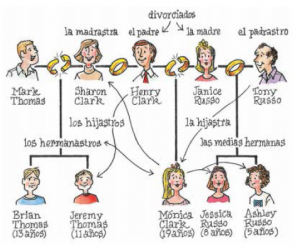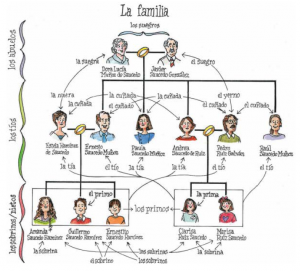Here are some quotes from Focus on Content-Based Language Teaching (Lightbown, 2014).
Author: gabiguillen
La importancia de la buena comida
La pasada semana estuve en Salinas y encontré este manual de la buena comida en las oficinas de una ONG. Creo que puede ser muy útil para sus clases de español: es material auténtico y puede activar tareas comunicativas de contenido social. Pueden combinarlo con estas fotos que tomé en un supermercado de Santa Cruz.
Virtual Exchanges: My dissertation in 500 words

My dissertation analyzed virtual exchanges and Language Learning Social Networks (LLSNs), responding to the lack of opportunities for oral interaction with expert speakers in second language instruction.
For most learners, the classroom is useful but insufficient. Generally, other means are required to develop intercultural competence and advanced proficiency. Communicative classes tend to encourage oral interaction but they are limited by time and space constraints, and by homework and assessment that do not necessarily favor intercultural and speaking skills.
Among other many outcomes, a satisfactory virtual exchange experience provides fluency development and might contribute to university internationalization.
Virtual exchanges could also ignite interest in studying abroad, taking into account that 56% of 8,606 US students “indicated they were considering overseas study” (British Council, 2013, p. 26), yet only 14% of students appears to go abroad (Open Doors, 2012). According to the British Council survey (p.37), students were mostly concerned with the cost of international study (75%), lack of confidence in language ability (44%), and difficulty of leaving behind parents and friends (39%). Tandems do not solve the first concern but they can help students gain language confidence and get out of their cultural comfort zone.
The affordances of virtual exchanges (VE) are well-documented in the literature. However, despite the significant potential of VE projects, they continue to be peripheral to foreign language education (O’Dowd, 2010, 2013) and remain largely dependent on instructor guidance, even with the growth of Language Learning Social Networking sites (LLSNs).
Inspired by the emergence of LLSNs and the current literature, my dissertation:
1) Assessed students’ knowledge and attitudes in regards to virtual exchanges and LLSNs, by means of a survey administered to 155 students and a preliminary experiment with virtual exchanges. The results encourage instructors and institutions to implement virtual exchange projects and the use of LLSNs at the curricular level.
2) Measured and described proficiency development through a 10 week hybrid Spanish course with a virtual exchange requirement, in contrast with a traditional course. The study found that both groups improved in the overall proficiency score. Furthermore, the hybrid learners outperformed the traditional course participants in regards to vocabulary, an indicator of fluency potential. A closer examination of the virtual exchange recordings from a qualitative perspective showed that virtual exchange participants increased language learning awareness and autonomy over time. In particular, learners who are more engaged and inquisitive from the first encounter seemed to progress at a faster rate.
3) Gave recommendations for using and developing LLSNs and explained the state of the art of what I called social Computer Assisted Language Learning (sCALL), an overarching term that includes not only LLSNs but virtual exchange platforms and networks that connect instructors and learners.
LLSNs should focus on strengthening the longevity of virtual exchange, ensuring that users find the most appropriate partners in terms of language level, interests, and location (connecting language learners in the same town). They should enhance feedback, translation tools, rating of users, tasks and projects, recordings, asynchronous and synchronous audiovisual features, and overall usability. The ideal LLSNs could be seen as an extension of the classroom, allowing learners to develop lifelong learning skills. The dialogue between developers and the language profession should flow naturally from the core of the common interests.
Textbook Analysis: Dos Mundos
I wrote this in 2011 as a graduate assignment but I believe it’s still relevant… And it was collecting dust in my cloud drive.
Dos Mundos, Comunicación y Comunidad ($176-234) claims to use a communicative design to help beginner students achieving competence in Spanish by means of comprehensible input, output activities, and explicit knowledge of rules. From Terrell’s Natural Approach (one of the authors of the original textbook) to the recent Focus on Form, Dos Mundos has experienced a relative evolution through its history responding to SLA studies and trends.
In this post I will examine the last edition of Dos Mundos (2010), a miscellaneous textbook that underemphasizes phonetics and pragmatics while emphasizing lexis and morphosyntax, the last two being treated simultaneously through input.
First, the sounds of Spanish are particularly underrepresented in the textbook, excluding ancillary materials. There is only an initial mention to the Spanish Alphabet with some spelling notes and one exercise (Dos Mundos 14-15), and the Appendix Three, which includes rules about syllabication and spelling changes, among others. None of these aspects are presented through input.
It is presumable that the authors do not emphasize the importance of phonetics because either they do not understand it as a complex issue for US students of Spanish, they expect teachers to cover this area through the oral communicative activities that abound in Dos Mundos, and/or they believe there are enough pronunciation activities and explanations in the workbook Cuaderno de actividades. Either way, after an exhaustive search, there were no references to phonetics issues or variations to be found.
The case of pragmatics is more ambiguous. Arbitrary notes about the use of language in context exist within the new section ¡Ojo! (which means Look out!). Although this information mostly refers to cultural differences and facts that are relevant to the topic, they do not blend with the input. Some of the activities also cover, superficially, pragmatics since they require students to place themselves in a Spanish speaking country. However, there is no explicit mention to pragmatics. Generally, teachers have to specifically mention –and act out– the importance of pragmatics in regards to communication through input and activities.
The authors are missing an excellent opportunity to introduce pragmatics through the grammar or vocabulary input that opens each section. This is not necessarily due to the artificial nature of textbooks since they could use or modify real situations with real pictures, instead of drawings about a family that rarely displays more than one cultural item: their Spanish last name. Even within the video resources (which are not relevant to this assignment), input is extremely adapted to language learners, avoiding pragmatics.
On the other hand, vocabulary is very important. Each chapter is associated with new vocabulary that it is presented through graphic input instead of a mere list of words –there is, for that reason, a context for lexicon elements that trigger communicative activities. It is not uncommon to find vocabulary linked to Hispanic characters, even though most vocabulary items are associated with familiar situations for college students with no reference to Hispanic cultures.


Particularly interesting is the approach to kinship lexicon (Dos Mundos, 312-313), in which the authors present a large Hispanic family with no broken unions, followed by what seems to be a US family (judging by their names) with divorced parents and children from different marriages. This unfortunate and perhaps unintended simplification represents an approach to vocabulary that could be improved with authentic pictures and different situations. The cultural contrast is necessary but it would be preferable to use real ethnography and data from different Hispanic societies. In fact, many Spanish instructors use their own material to present the same vocabulary shown in Dos Mundos (and some rarely use the textbook).
Still, the connection between vocabulary and communicative activities is reasonably successful and it gives a new dimension to the initial input. Furthermore, within each chapter, different activities provide new input which is gradually more authentic, including pictures, modified readings and authentic texts.
Elements of morphosyntax are presented in a similar way to lexicon items, which is to say, by graphic input and connections with activities. Simultaneously, both levels are combined through a series of communicative situations. Some examples are festivities, work, residence, food, trips, past and present. In these scenarios, there are not explicit references to grammar, although students are guided to use specific structures in meaningful activities. Also, each chapter includes a final section with explicit grammar explanations, and Dos Mundos asks students to read them before exposure to input.
Both explicit and implicit morphosyntax have a decisive role in the textbook. It is not just a “gentle focus on form”, (Dos Mundos, XXIII) as the authors claim, but part of its backbone, in combination with the vocabulary, activities and notional-functional vertebrae.
As a consequence, it is difficult to define Dos Mundos as a textbook that strictly follows the principles of Communicative Language Teaching (CLT), although we must remember that the CLT is a flexible approach where “drilling may occur, but peripherally” (Finocchiario and Brumfit) and “any device which helps the learner is accepted – varying according to their age, interest, etc” (ibid.).
Dos Mundos intends to “make language acquisition theory work in the classroom” (Dos Mundos XII). However, their theoretical framework is undefined. It seems to be a blend of different approaches: Krashen, Terrell, CLT, Focus on Form, and even TPR. Consequently, it would be more accurate to claim that their goal is to simply make second language acquisition work in the classroom. In order to achieve this new goal, Dos Mundos should improve the quality and authenticity of input and activities, ensuring the integration of pragmatics.
Entrevista a Jaime Rosales: “mi cine no se parece al cine”
La última película de Jaime Rosales, Hermosa juventud, es un retrato hiperrealista de una pareja de jóvenes de clase obrera en paro. Pese a lo crudo del tema, es su película más comercial, con caras guapas, acción, secuencias a ritmo de WhatsApp y una colaboración con Torbe, al estilo de Torrente.
Las diferencias son evidentes en el tráiler aunque, en realidad, Hermosa juventud mantiene las constantes vitales de un cine auténtico, arriesgado y genial, un cine que plasma, como pocos en España, la forma en la que hablamos, sin aditivos. Sin condescendencia. Icíar Bollaín, Bigas Luna, Daniel Monzón, Carlos Saura, Eloy de la Iglesia, Pedro Almodóvar, Fernando León… Ninguno de ellos se acerca a la meticulosidad de Rosales en la representación del lenguaje de la calle. Por eso mismo lo entrevisté, como lingüista, como amante del séptimo arte y enamorado de la diversidad y las contradicciones del habla.
Continue reading Entrevista a Jaime Rosales: “mi cine no se parece al cine”